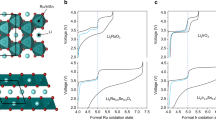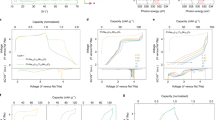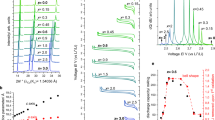Abstract
Reversible high-voltage redox chemistry is an essential component of many electrochemical technologies, from (electro)catalysts to lithium-ion batteries. Oxygen-anion redox has garnered intense interest for such applications, particularly lithium-ion batteries, as it offers substantial redox capacity at more than 4 V versus Li/Li+ in a variety of oxide materials. However, oxidation of oxygen is almost universally correlated with irreversible local structural transformations, voltage hysteresis and voltage fade, which currently preclude its widespread use. By comprehensively studying the Li2−xIr1−ySnyO3 model system, which exhibits tunable oxidation state and structural evolution with y upon cycling, we reveal that this structure–redox coupling arises from the local stabilization of short approximately 1.8 Å metal–oxygen π bonds and approximately 1.4 Å O–O dimers during oxygen redox, which occurs in Li2−xIr1−ySnyO3 through ligand-to-metal charge transfer. Crucially, formation of these oxidized oxygen species necessitates the decoordination of oxygen to a single covalent bonding partner through formation of vacancies at neighbouring cation sites, driving cation disorder. These insights establish a point-defect explanation for why anion redox often occurs alongside local structural disordering and voltage hysteresis during cycling. Our findings offer an explanation for the unique electrochemical properties of lithium-rich layered oxides, with implications generally for the design of materials employing oxygen redox chemistry.
This is a preview of subscription content, access via your institution
Access options
Access Nature and 54 other Nature Portfolio journals
Get Nature+, our best-value online-access subscription
$29.99 / 30 days
cancel any time
Subscribe to this journal
Receive 12 print issues and online access
$259.00 per year
only $21.58 per issue
Buy this article
- Purchase on Springer Link
- Instant access to full article PDF
Prices may be subject to local taxes which are calculated during checkout





Similar content being viewed by others
Data availability
All experimental data within the article and its Supplementary Information will be made available upon reasonable request to the authors.
References
Whittingham, M. S. Ultimate limits to intercalation reactions for lithium batteries. Chem. Rev. 114, 11414–11443 (2014).
Assat, G. & Tarascon, J.-M. Fundamental understanding and practical challenges of anionic redox activity in Li-ion batteries. Nat. Energy 3, 373–386 (2018).
Sathiya, M. et al. Reversible anionic redox chemistry in high-capacity layered-oxide electrodes. Nat. Mater. 12, 827–835 (2013).
Luo, K. et al. Charge-compensation in 3d-transition-metal-oxide intercalation cathodes through the generation of localized electron holes on oxygen. Nat. Chem. 8, 684–691 (2016).
Seo, D.-H. et al. The structural and chemical origin of the oxygen redox activity in layered and cation-disordered Li-excess cathode materials. Nat. Chem. 8, 692–697 (2016).
Gent, W. E. et al. Coupling between oxygen redox and cation migration explains unusual electrochemistry in lithium-rich layered oxides. Nat. Commun. 8, 2091 (2017).
Zhan, C. et al. Enabling the high capacity of lithium-rich anti-fluorite lithium iron oxide by simultaneous anionic and cationic redox. Nat. Energy 2, 963–971 (2017).
Assat, G., Delacourt, C., Corte, D. A. D. & Tarascon, J.-M. Editors’ choice—practical assessment of anionic redox in Li-rich layered oxide cathodes: a mixed blessing for high energy Li-ion batteries. J. Electrochem. Soc. 163, A2965–A2976 (2016).
Sathiya, M. et al. Origin of voltage decay in high-capacity layered oxide electrodes. Nat. Mater. 14, 230–238 (2014).
Dogan, F. et al. Re-entrant lithium local environments and defect driven electrochemistry of Li- and Mn-rich Li-ion battery cathodes. J. Am. Chem. Soc. 137, 2328–2335 (2015).
Croy, J. R. et al. Examining hysteresis in composite xLi2MnO3·(1-x)LiMO2 cathode structures. J. Phys. Chem. C 117, 6525–6536 (2013).
Kleiner, K. et al. Origin of high capacity and poor cycling stability of Li-rich layered oxides: a long-duration in situ synchrotron powder diffraction study. Chem. Mater. 30, 3656–3667 (2018).
Abdellahi, A., Urban, A., Dacek, S. & Ceder, G. The effect of cation disorder on the average Li intercalation voltage of transition-metal oxides. Chem. Mater. 28, 3659–3665 (2016).
Konishi, H. et al. Potential hysteresis between charge and discharge reactions in Li1.2Ni0.13Mn0.54Co0.13O2 for lithium ion batteries. Solid State Ion. 300, 120–127 (2017).
McCalla, E. et al. Visualization of O–O peroxo-like dimers in high-capacity layered oxides for Li-ion batteries. Science 350, 1516–1521 (2015).
Luo, K. et al. Anion redox chemistry in the cobalt free 3d transition metal oxide intercalation electrode Li[Li0.2Ni0.2Mn0.6]O2. J. Am. Chem. Soc. 138, 11211–11218 (2016).
Kobayashi, H., Tabuchi, M., Shikano, M., Kageyama, H. & Kanno, R. Structure, and magnetic and electrochemical properties of layered oxides, Li2IrO3. J. Mater. Chem. 13, 957–962 (2003).
Delmas, C., Braconnier, J.-J., Fouassier, C. & Hagenmuller, P. Electrochemical intercalation of sodium in NaxCoO2 bronzes. Solid State Ion. 3-4, 165–169 (1981).
Perez, A. J. et al. Approaching the limits of cationic and anionic electrochemical activity with the Li-rich layered rocksalt Li3IrO4. Nat. Energy 2, 954–962 (2017).
Grimaud, A., Hong, W. T., Shao-Horn, Y. & Tarascon, J. M. Anionic redox processes for electrochemical devices. Nat. Mater. 15, 121–126 (2016).
Yabuuchi, N. et al. Origin of stabilization and destabilization in solid-state redox reaction of oxide ions for lithium-ion batteries. Nat. Commun. 7, 13814 (2016).
Choy, J.-H., Kim, D.-K., Hwang, S.-H., Demazeau, G. & Jung, D.-Y. XANES and EXAFS Studies on the Ir–O bondcovalency in ionic iridium perovskites. J. Am. Chem. Soc. 117, 8557–8566 (1995).
Mugavero, S. J., Smith, M. D., Yoon, W.-S. & zur Loye, H.-C. Nd2K2IrO7 and Sm2K2IrO7: iridium(VI) oxides prepared under ambient pressure. Angew. Chem. Int. Ed. 48, 215–218 (2009).
Laguna-Marco, M. A. et al. Electronic structure, local magnetism, and spin–orbit effects of Ir(IV)-, Ir(V)-, and Ir(VI)-based compounds. Phys. Rev. B 91, 214433 (2015).
Qi, B., Perez, I., Ansari, P. H., Lu, F. & Croft, M. L 2 and L 3 measurements of transition-metal 5d orbital occupancy, spin-orbit effects, and chemical bonding. Phys. Rev. B 36, 2972–2975 (1987).
Yoon, W.-S. et al. Investigation of the charge compensation mechanism on the electrochemically Li-ion deintercalated Li1-xCo1/3Ni1/3Mn1/3O2 electrode system by combination of soft and hard X-ray absorption spectroscopy. J. Am. Chem. Soc. 127, 17479–17487 (2005).
Mortemard de Boisse, B., Liu, G., Ma, J., Nishimura, S.-I. & Chung, S.-C. et al. Intermediate honeycomb ordering to trigger oxygen redox chemistry in layered battery electrode. Nat. Commun. 7, 11397 (2016).
Qiao, R. et al. Direct experimental probe of the Ni(II)/Ni(III)/Ni(IV) redox evolution in LiNi0.5Mn1.5O4 electrodes. J. Phys. Chem. C 119, 27228–27233 (2015).
Liu, X. et al. Why LiFePO4 is a safe battery electrode: Coulomb repulsion induced electron-state reshuffling upon lithiation. Phys. Chem. Chem. Phys. 17, 26369–26377 (2015).
Maitra, U. et al. Oxygen redox chemistry without excess alkali-metal ions in Na2/3[Mg0.28Mn0.72]O2. Nat. Chem. 10, 288–295 (2018).
Xu, J. et al. Elucidating anionic oxygen activity in lithium-rich layered oxides. Nat. Commun. 9, 947 (2018).
Chen, H. & Islam, M. S. Lithium extraction mechanism in Li-rich Li2MnO3 involving oxygen hole formation and dimerization. Chem. Mater. 28, 6656–6663 (2016).
Cramer, C. J., Tolman, W. B., Theopold, K. H. & Rheingold, A. L. Variable character of O–O and M–O bonding in side-on (η2) 1:1 metal complexes of O2. Proc. Natl Acad. Sci. USA 100, 3635–3640 (2003).
Hay-Motherwell, R. S., Wilkinson, G., Hussain-Bates, B. & Hursthouse, M. B. Synthesis and X-ray crystal structure of oxotrimesityliridium(V). Polyhedron 12, 2009–2012 (1993).
Winkler J. R., & Gray H. B. in Molecular Electronic Structures of Transition Metal Complexes I (eds Mingos, D. M. P., Day, P. & Dahl, J. P.) 17–28 (Springer, Berlin, 2012).
Zhuo, Z. et al. Spectroscopic signature of oxidized oxygen states in peroxides. J. Phys. Chem. Lett. 9, 6378–6384 (2018).
Hennies, F. et al. Resonant inelastic scattering spectra of free molecules with vibrational resolution. Phys. Rev. Lett. 104, 193002 (2010).
Talaie, E., Kim, S. Y., Chen, N. & Nazar, L. F. Structural evolution and redox processes involved in the electrochemical cycling of P2-Na0.67[Mn0.66Fe0.20Cu0.14]O2. Chem. Mater. 29, 6684–6697 (2017).
Gilbert, B. et al. Multiple scattering calculations of bonding and X-ray absorption spectroscopy of manganese oxides. J. Phys. Chem. A 107, 2839–2847 (2003).
Benedek, R. First-cycle simulation for Li-rich layered oxide cathode material xLi2MnO3 (1-x)LiMO2 (x=0.4). J. Electrochem. Soc. 165, A2667–A2674 (2018).
Mohanty, D. et al. Unraveling the voltage-fade mechanism in high-energy-density lithium-ion batteries: origin of the tetrahedral cations for spinel conversion. Chem. Mater. 26, 6272–6280 (2014).
Ceder, G. & Van der Ven, A. Phase diagrams of lithium transition metal oxides: investigations from first principles. Electrochim. Acta 45, 131–150 (1999).
Thackeray, M. M. et al. Li2MnO3-stabilized LiMO2 (M=Mn, Ni, Co) electrodes for lithium-ion batteries. J. Mater. Chem. 17, 3112–3125 (2007).
Okubo, M. & Yamada, A. Molecular orbital principles of oxygen-redox battery electrodes. ACS Appl. Mater. Interfaces 9, 36463–36472 (2017).
Mortemard de Boisse, B. et al. Highly reversible oxygen-redox chemistry at 4.1 V in Na4/7−x [□1/7 Mn6/7]O2 (□:Mn vacancy). Adv. Energy Mater. 8, 1800409 (2018).
Rong, X. et al. Structure-induced reversible anionic redox activity in Na layered oxide cathode. Joule 2, 125–140 (2018).
Surendranath, Y., Kanan, M. W. & Nocera, D. G. Mechanistic studies of the oxygen evolution reaction by a cobalt-phosphate catalyst at neutral pH. J. Am. Chem. Soc. 132, 16501–16509 (2010).
Grimaud, A. et al. Activating lattice oxygen redox reactions in metal oxides to catalyse oxygen evolution. Nat. Chem. 9, 457–465 (2017).
Billow, B. S., McDaniel, T. J. & Odom, A. L. Quantifying ligand effects in high-oxidation-state metal catalysis. Nat. Chem. 9, 837–842 (2017).
Snyder, B. E. R. et al. The active site of low-temperature methane hydroxylation in iron-containing zeolites. Nature 536, 317–321 (2016).
Chuang, Y.-D. et al. Modular soft x-ray spectrometer for applications in energy sciences and quantum materials. Rev. Sci. Instrum. 88, 013110 (2017).
Kresse, G. & Hafner, J. Ab initio molecular dynamics for liquid metals. Phys. Rev. B 47, 558–561 (1993).
Kresse, G. & Hafner, J. Ab initio molecular-dynamics simulation of the liquid–metal amorphous–semiconductor transition in germanium. Phys. Rev. B 49, 14251–14269 (1994).
Kresse, G. & Furthmüller, J. Efficient iterative schemes for ab initio total-energy calculations using a plane-wave basis set. Phys. Rev. B 54, 11169–11186 (1996).
Kresse, G. & Furthmüller, J. Efficiency of ab-initio total energy calculations for metals and semiconductors using a plane-wave basis set. Comput. Mater. Sci. 6, 15–50 (1996).
Blöchl, P. E. Projector augmented-wave method. Phys. Rev. B 50, 17953–17979 (1994).
Kresse, G. & Joubert, D. From ultrasoft pseudopotentials to the projector augmented-wave method. Phys. Rev. B 59, 1758–1775 (1999).
Perdew, J. P., Burke, K. & Ernzerhof, M. Generalized gradient approximation made simple. Phys. Rev. Lett. 77, 3865–3868 (1996).
Dudarev, S. L., Botton, G. A., Savrasov, S. Y., Humphreys, C. J. & Sutton, A. P. Electron-energy-loss spectra and the structural stability of nickel oxide: an LSDA+U study. Phys. Rev. B 57, 1505–1509 (1998).
Subedi, A. First-principles study of the electronic structure and magnetism of CaIrO3. Phys. Rev. B 85, 020408 (2012).
Heyd, J., Scuseria, G. E. & Ernzerhof, M. Hybrid functionals based on a screened Coulomb potential. J. Chem. Phys. 118, 8207–8215 (2003).
Seo, D.-H., Urban, A. & Ceder, G. Calibrating transition-metal energy levels and oxygen bands in first-principles calculations: accurate prediction of redox potentials and charge transfer in lithium transition-metal oxides. Phys. Rev. B 92, 115118 (2015).
Grimme, S. Semiempirical GGA-type density functional constructed with a long-range dispersion correction. J. Comput. Chem. 27, 1787–1799 (2006).
Peng, H., Yang, Z.-H., Perdew, J. P. & Sun, J. Versatile van der Waals density functional based on a meta-generalized gradient approximation. Phys. Rev. X 6, 041005 (2016).
Hart, G. L. W. & Forcade, R. W. Algorithm for generating derivative structures. Phys. Rev. B 77, 224115 (2008).
Hart, G. L. W., Nelson, L. J. & Forcade, R. W. Generating derivative structures at a fixed concentration. Comput. Mater. Sci. 59, 101–107 (2012).
Wales, D. J. & Doye, J. P. K. Global optimization by basin-hopping and the lowest energy structures of Lennard-Jones clusters containing up to 110 atoms. J. Phys. Chem. A 101, 5111–5116 (1997).
Acknowledgements
This research was supported by the Assistant Secretary for Energy Efficiency and Renewable Energy, Office of Vehicle Technologies, Battery Materials Research Program, US Department of Energy (DOE). W.E.G. was supported additionally by the Advanced Light Source Doctoral Fellowship and the Siebel Scholars programme. K.L. was supported additionally by the Kwanjeong Education Foundation Fellowship. Use of the ALS was supported by the Office of Science, Office of Basic Energy Sciences, of the US DOE under contract no. DE-AC02-05CH11231. Use of the SSRL, SLAC National Accelerator Laboratory, was supported by the Office of Science, Office of Basic Energy Sciences, of the US DOE under contract no. DE-AC02-76SF00515. Work at the Molecular Foundry was supported by the Office of Science, Office of Basic Energy Sciences, of the US DOE under contract no. DE-AC02-05CH11231. Part of this work was performed at the Stanford Nano Shared Facilities, supported by the National Science Foundation under award ECCS-1542152. This research used resources of the APS, an Office of Science User Facility operated for the US DOE Office of Science by Argonne National Laboratory, and was supported by the US DOE under contract no. DE-AC02-06CH11357, and the Canadian Light Source and its funding partners. The computational work was funded by the NorthEast Center for Chemical Energy Storage, an Energy Frontier Research Center, supported by the US DOE, Office of Science, Office of Basic Energy Sciences under award no. DE-SC0012583. G.C. also thanks the China Automotive Battery Research Institute and the General Research Institute for NonFerrous Metals for financial support on oxygen redox in cathode materials. W.E.G. thanks Ariel Jacobs for insightful discussions on metal–oxygen bonding interactions. The authors thank Karena Chapman (APS) for valuable comments on X-ray total scattering analysis.
Author information
Authors and Affiliations
Contributions
J.H., W.E.G., W.C.C. and M.F.T. conceived the study. J.H. carried out materials synthesis, characterization and testing. J.H. and K.L. performed ex situ and operando synchrotron measurements including XRD, PDF, XAS, sXAS and RIXS. J.H. and W.E.G. measured ex situ STXM and RIXS spectra. W.E.G., J.W. and W.Y. processed and analysed spectroscopic data. K.L., J.H., K.H.S., D. Passarello and M.F.T. performed the structural analyses. K.L., J.H., C.J.T., M.F.T. and W.C.C. designed and constructed settings for in situ synchrotron measurements. P.X., D.-H.S. and G.C. conducted DFT calculations. J.W., K.H.S., D.N., C.-J.S. and K.L. configured synchrotron end stations. P.M.C. provided constructive advice for experiments. J.H., W.E.G., D. Prendergast, W.C.C. and M.F.T. devised the oxygen redox model. J.H., W.E.G., G.C., W.C.C. and M.F.T. wrote the manuscript and all authors revised the manuscript.
Corresponding authors
Ethics declarations
Competing interests
The authors declare no competing interests.
Additional information
Publisher’s note: Springer Nature remains neutral with regard to jurisdictional claims in published maps and institutional affiliations.
Supplementary information
Rights and permissions
About this article
Cite this article
Hong, J., Gent, W.E., Xiao, P. et al. Metal–oxygen decoordination stabilizes anion redox in Li-rich oxides. Nature Mater 18, 256–265 (2019). https://doi.org/10.1038/s41563-018-0276-1
Received:
Accepted:
Published:
Issue Date:
DOI: https://doi.org/10.1038/s41563-018-0276-1
This article is cited by
-
Eutectic salt-assisted planetary centrifugal deagglomeration for single-crystalline cathode synthesis
Nature Energy (2023)
-
Decoupling the roles of Ni and Co in anionic redox activity of Li-rich NMC cathodes
Nature Materials (2023)
-
Stabilizing lattice oxygen redox in layered sodium transition metal oxide through spin singlet state
Nature Communications (2023)
-
Delocalized electron holes on oxygen in a battery cathode
Nature Energy (2023)
-
Slab gliding, a hidden factor that induces irreversibility and redox asymmetry of lithium-rich layered oxide cathodes
Nature Communications (2023)



